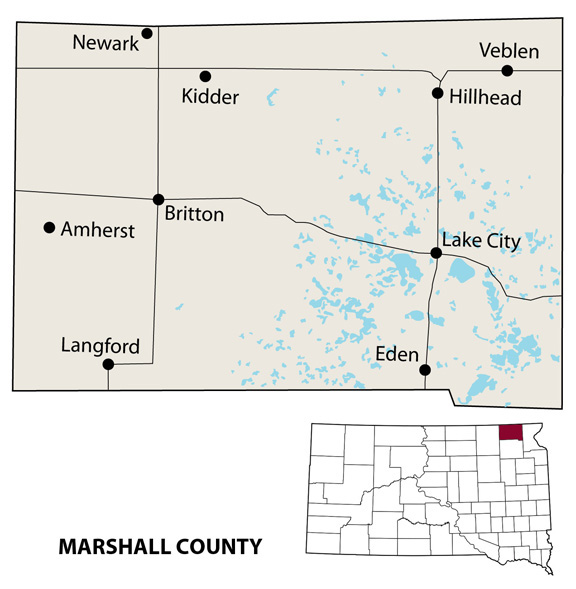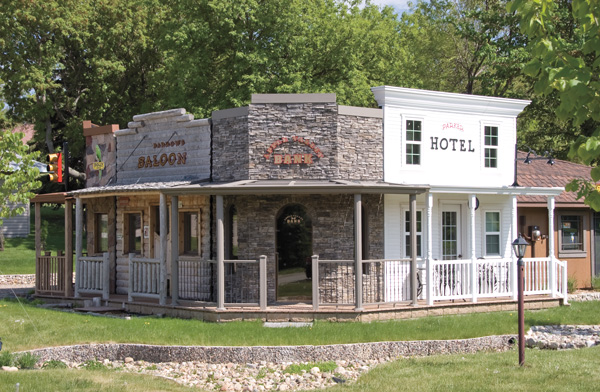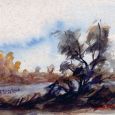The Gift of South Dakota
Subscriptions to South Dakota Magazine make great gifts!
Subscribe today — 1 year (6 issues) is just $29!
The Land and the Sea
Jun 2, 2015
 |
Look at a detailed road atlas of Marshall County in northeastern South Dakota and you’ll see a distinct divide. The western half is an almost undisturbed patchwork of county roads leading to towns like Britton, Langford, Kidder and Amherst. East Marshall County is pockmarked with glacial lakes, ponds and sloughs, meaning the distance between Lake City and Fort Sisseton as the crow flies is much different than actual drive time.
We talk much about the cultural differences between West River and East River South Dakota, but I doubt they pertain to Marshall County. This is farm country through and through, although the lakes do add recreational fun and historical mystique.
Marshall County was created in 1885. Day County, which then extended north to the 46th parallel, was cut nearly in half. The new northern county was then named for Marshall Vincent, a New York native who homesteaded near Andover in 1881 and was a county commissioner at the time of the split.
An 1886 history of the area credits Charles Bailey as the first occupant of Marshall County; he homesteaded in Victor Township in 1881. But of course Plains Indians inhabited the region for centuries. In fact, the western boundary of the Lake Traverse Reservation runs diagonally north to south through the eastern quarter of the county.
 |
| Families glimpse 19th century life at Fort Sisseton. Photo by S.D State Parks. |
Legends passed through oral history are an important part of Native culture. Several lakes in eastern Marshall County have names with origins rooted in ancient stories. Emma Lake lies along the Marshall and Roberts County line, just north of Highway 10. It is named for Emma Mato, who had a lodge on the lakeshore. One winter her lover tried to walk to her home across the frozen pond but fell through. Emma paced the shoreline for months calling his name, but he never returned. Locals began calling it Emma’s Lake.
A huge buffalo herd became trapped in the thick trees around a chain of lakes in southeastern Marshall County during a four-day blizzard. Pleased with their kill, Indians named the place “The Buffalo Hunt in the Woods,” later shortened to Buffalo Lakes.
Long Lake near Lake City could hold buried treasure. A Santee named Gray Food told his sons on his deathbed in 1910 that he buried a flour sack full of gold coins worth $56,000 between two willow trees on the lake’s east shore. His sons tried many times to find the gold, but always left empty handed.
The Indian presence in the area was the reason behind building Fort Sisseton in 1864. The fort lies southwest of Lake City and hosts an annual historical festival (June 5-7). Visitors can walk the grounds and step inside the original officers’ quarters, stone barracks, guardhouse and other buildings. New this summer is the display of a rediscovered 38-star post flag. The staff believes it was the last flag to fly over Fort Sisseton before it was decommissioned in 1889.
There are other unique places to visit around Marshall County. Several years ago a writer stopped in Eden, pop. 91, and discovered that the bar and grill called Club Eden hosted an all-you-can-eat bullhead fish fry every Friday night. Since then, about 20 local investors bought the business and replaced the bullheads with chicken wing Wednesdays.
 |
| If you look hard enough in Britton, you'll find the 1930s. |
A farm just outside of Langford features a tribute to a young homesteader who died aboard the Titanic in 1912. Ole Olson’s parents were from Norway and homesteaded near Langford. He grew up there and later moved to Canada. He was returning from a trip to Norway when the Titanic sunk.
In 2003, Olson’s grandnephew Harlan was refurbishing the granary when he found Ole’s name carved into the wall. They figure Ole did it sometime between 1885 and 1912.
We were surprised in Britton one day when we encountered an entire 1930s Main Street. There was a saloon, hotel, bank and gas station with vintage cars parked outside. It’s the creation of Don Schumaker, who runs Schumaker Home Furnishings. He and his wife Norma operate the unique setup as Apple Valley Rentals.
 |
| "I'm a sucker for clouds," Marshall County photographer John Front told us. "I often don't go out unless there are clouds." |
We’ve met plenty of interesting people from Marshall County including Frank Farrar, who served as governor of South Dakota from 1969-71. The 85-year-old was the subject of a recent television news story about his athletic and aerial exploits (he’s a pilot and triathlete). We’ve been meaning to get to Britton to catch up with Frank.
Another was John Front, who provided a window into Marshall County through his photographs. When we met him in 2004 he was 85 and had a collection of about 30,000 images, many of them taken in his home county. You’ll see John Front photos hanging in businesses around Britton today, and we used several of them to illustrate a book called South Dakota Farmscapes. He showed us why landlubbers and sailors alike enjoy their time in Marshall County.
Editor’s Note: This is the third installment in an ongoing series featuring South Dakota’s 66 counties. Click here for previous articles.










Comments